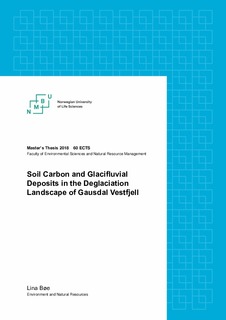| dc.description.abstract | Glacifluvial deposits and their soil carbon stock and stability have been studied in the deglaciation landscape of Gausdal Vestfjell, Norway. Soil profiles are described and sampled for parent material clast analysis, density calculation and soil chemical analysis across a variety of glacifluvial landforms deposited in both flowing and stagnant ice, subaerially as well as subaqueously. The landforms include eskers, kame, kame terraces, delta and fan deposits. The morphology and sedimentology of 17 landforms are described and interpreted from remote sensing and field investigation. Methods have included visualization of LiDAR data in ArcMap, stratigraphic logging, sediment property analysis and Ground Penetrating Radar measurements. Calculation of carbon stock is based on soil density, stone and boulder content, horizon thickness and laboratory measurements of total carbon content.
Gausdal Vestfjell was deglaciated by down-wasting of stagnant ice, where kame terraces at the highest elevations (820-890 masl) record a progressive lowering of the ice surface. Fan, delta and sandur deposits record ice-damming and gradual drainage of meltwater from the lowest elevations (778-810 masl). The glacifluvial deposits are subangular, sorted and mainly composed of sand and gravel although both finer and coarser sediments occur. The deposits are dominated by tabular and through cross bedding, current ripples and horizontal lamination, erosive surfaces and variable discharge mainly in the upper flow regime.
The carbon stocks can be linked to depositional environments and processes during deglaciation. Early and late stage deposition at high (~890 masl) and low elevation (~790 masl), respectively, resulted in low carbon stocks, while deposition in stagnating ice at intermediate elevations is linked to high carbon stocks (~850 masl). The coarse texture of the deposits limits carbon input, decomposition, translocation and stabilisation due to low total particle surface area and water and nutrient retention capacity. Soil texture further exerts a major influence on carbon stocks through organic material occlusion and complexation with minerals, and a doubling of the silt and clay content from 20 % to 40 % nearly triples carbon stock. The texture varies greatly due to large variations between and within depositional environments and processes, and the glacifluvial carbon stocks are thus linked to the formation of the landforms they are found on.
The carbon stock of the soils is estimated down through the Bs horizon, and ranges from ~ 3 to 18 kg/m2, with a mean estimated to 7.99 kg/m2. The fraction stored in the mineral soil is highly variable and ranges from ~10 % to ~ 100 %, averaging at 63 %. Soil organic carbon varies with the nutrition status of the nearby bedrock and parent material, the degree of soil formation and the nature of sediment transport and deposition. The degree of soil formation is higher in soils formed from innutritious parent material. The soil carbon stock is higher in soil formed on landforms composed of immature sediment, deposited in the lower flow regime and with a low relief with the surrounding landscape. Stabilisation of organic carbon in the mineral soil depends on the presence of clay minerals in the parent material and soil weathering products including iron and aluminium oxides and phyllosilicates. Mineral-stabilised carbon in soil of nutritious parent material may show higher chemical recalcitrance, while carbon stabilised in more acidic soils formed from less nutritious parent material may be more labile and to a larger degree stabilised by oxides.
Upscaling of carbon stock estimates from the detailed study of selected landforms was done by georeferencing a bedrock map and a topographic map based on LiDAR data to all landforms mapped by remote sensing in the study area (c. 500). Parent material nutrition status can be inferred from the local bedrock, and the nature of deposition from the shape of landforms and their relationship with the surrounding landscape. The small number of deposits studied provides no statistical significance for extrapolation, however, the trends and variation in the carbon stocks of glacifluvial soils appear to be predictable. By upscaling, the organic horizon carbon stocks of the glacifluvial soils were estimated to be equivalent to ~121 Mg CO2/ha, and the carbon stocks of the mineral soil horizons to ~ 241 Mg CO2/ha. The former is unstable and may be lost from the deglaciation landscape to the atmosphere in a warmer climate while the latter may be lost if there is a change in land use. Overall, the landforms show large carbon stock variations for both organic and mineral soil horizons. Calculated values are comparable to values obtained in previous studies for carbon stocks of forest soils in mountainous ecosystems. | nb_NO |
| dc.description.abstract | Glasifluviale avsetninger og deres karbonlager er studert i isavsmeltingslandskapet i Gausdal Vestfjell, Oppland. Jordprofiler fra fire glasifluviale landformer er beskrevet, og det er tatt prøver for analyse av opphavsmateriale, jordtetthet og jordkjemiske egenskaper fra tolv landformer. Morfologien og sedimentologien til i alt 17 landformer, inkludert eskere, kame, kameterrasse, delta og vifteavsetninger er beskrevet og tolket basert på fjernanalyse og feltundersøkelse, blant annet ved fremstilling av LiDAR-data i Arc MAP, stratigrafisk logging, analyse av sedimentegenskaper og geroradarmålinger. Beregning av karbonlager er basert på jordtetthet, innhold av stein og blokk, sjikttykkelse, og laboratorieanalyse av jordas innhold av total karbon. | nb_NO |

